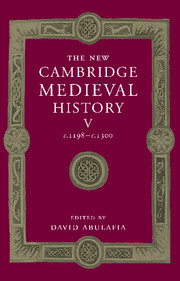Book contents
- Frontmatter
- Introduction
- Part I Common Themes
- Part II The Church in the Thirteenth Century
- Part III The Western Kingdoms
- Part IV Italy
- Part V The Mediterranean Frontiers
- 17 Byzantium after the Fourth Crusade
- 18 The crusades
- (a) The thirteenth-century crusades in the Mediterranean
- (b) The crusader states
- 19 Islam and the Mediterranean
- 20 The rise of Aragon-Catalonia
- 21 Castile, Portugal and Navarre
- Part VI The Northern and Eastern Frontiers
- Appendix Genealogical tables
- Primary sources and secondary works arranged by chapter
- Index
- Plate section
- Map 1 Europe in the thirteenth century
- Map 3 France, c. 1260
- Map 5 Germany and the western empire
- Map 6 Genoa, Venice and the Mediterranean
- Map 8 The Latin empire of Constantinople and its neighbours
- Map 10 Aragon and Anjouin the Mediterranean">
- References
(b) - The crusader states
from 18 - The crusades
Published online by Cambridge University Press: 28 March 2008
- Frontmatter
- Introduction
- Part I Common Themes
- Part II The Church in the Thirteenth Century
- Part III The Western Kingdoms
- Part IV Italy
- Part V The Mediterranean Frontiers
- 17 Byzantium after the Fourth Crusade
- 18 The crusades
- (a) The thirteenth-century crusades in the Mediterranean
- (b) The crusader states
- 19 Islam and the Mediterranean
- 20 The rise of Aragon-Catalonia
- 21 Castile, Portugal and Navarre
- Part VI The Northern and Eastern Frontiers
- Appendix Genealogical tables
- Primary sources and secondary works arranged by chapter
- Index
- Plate section
- Map 1 Europe in the thirteenth century
- Map 3 France, c. 1260
- Map 5 Germany and the western empire
- Map 6 Genoa, Venice and the Mediterranean
- Map 8 The Latin empire of Constantinople and its neighbours
- Map 10 Aragon and Anjouin the Mediterranean">
- References
Summary
THE departure of Richard Coeur de Lion and his army from Acre in October 1192 marked the end of the Third Crusade. The combined might of the west had failed in its primary object of winning back Jerusalem and the other holy places for Christendom, but the crusade had nevertheless achieved some signal successes. The truce agreed with Saladin the previous month had restricted Frankish-held territory in what remained of the kingdom of Jerusalem to the coastal areas, but at least the Christians had salvaged something from the disasters of 1187, and the kingdom was to survive, though within greatly reduced borders, for another hundred years. It was not until 1291 that the Muslims finally put an end to the Latin presence in Syria. To the north the cities of Antioch and Tripoli had held out against Saladin, and they too had a long future ahead of them, with the Christians maintaining their rule in Antioch until 1268 and in Tripoli until 1289. But here again there had been serious territorial losses. Further north still, beyond the Amanus mountains and now occupying a wide area including the plain of Cilicia and the Taurus mountains, lay the principality of Armenia. The collapse of Byzantine power in this region in the early 1180s had given the Armenians the opportunity to expand, and in 1198 their prince, Leon, received his royal crown from pope and emperor, and so inaugurated a monarchy which throughout its existence looked alternatively to western Europe and to Armenian traditionalism for inspiration and sustenance. For most of the thirteenth century the Cilician kingdom of Armenia was a considerable force, and it did not finally succumb to Muslim encroachments until the 1370s. The other Christian possession in the east was Cyprus. Richard’s seizure of the island in 1191 and his establishment of a Latin regime headed by the former king of Jerusalem, Guy of Lusignan, proved to be the most durable achievement of the Third Crusade. Guy died in 1194. Two years later his brother Aimery persuaded the western emperor, Henry VI, to constitute Cyprus as a kingdom with himself as the first king.
Keywords
- Type
- Chapter
- Information
- The New Cambridge Medieval History , pp. 590 - 606Publisher: Cambridge University PressPrint publication year: 1999
References
- 1
- Cited by

